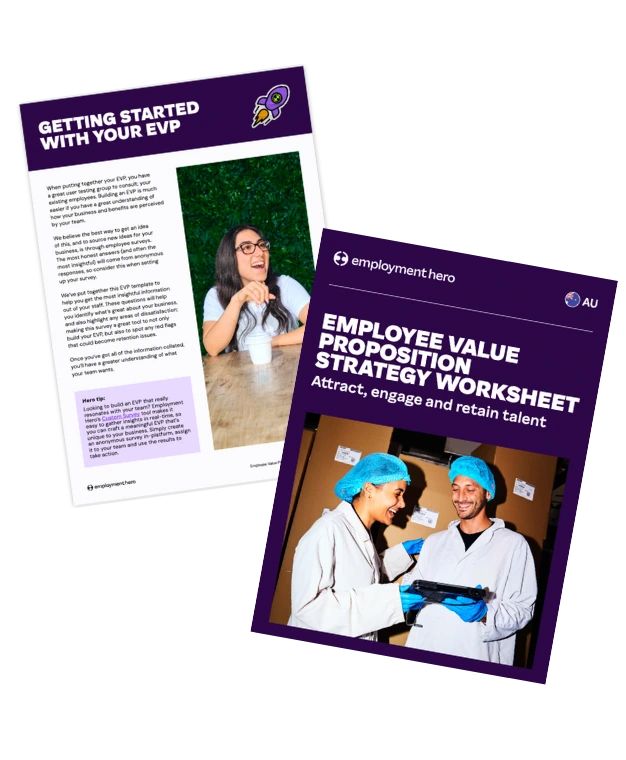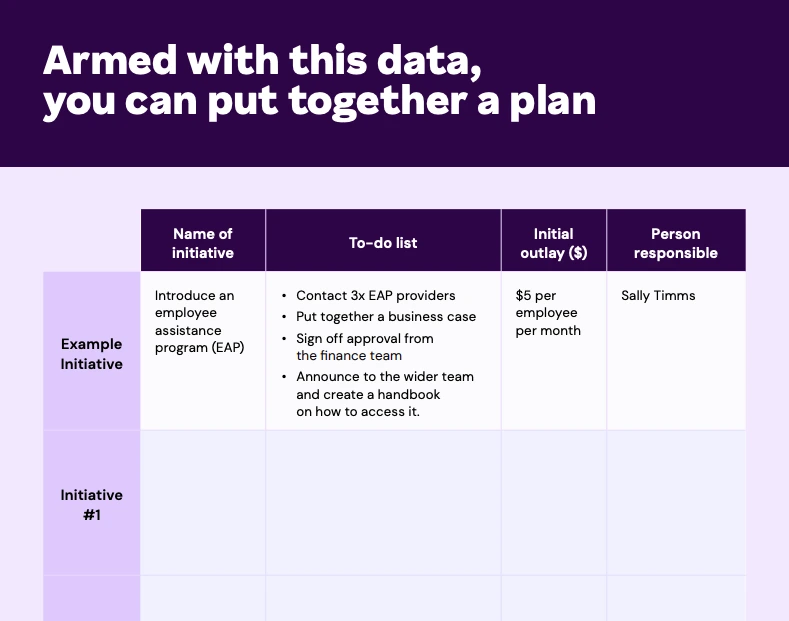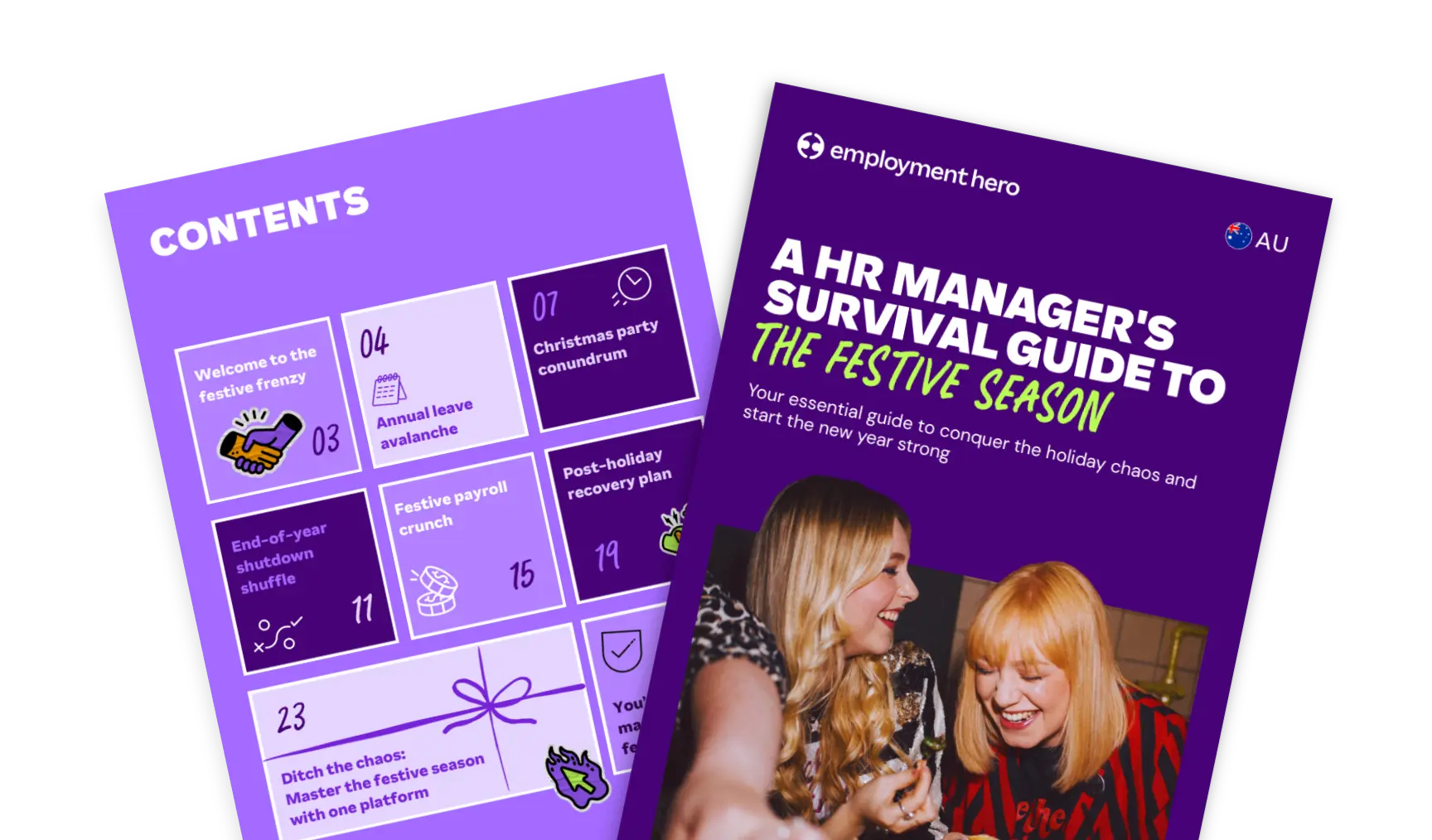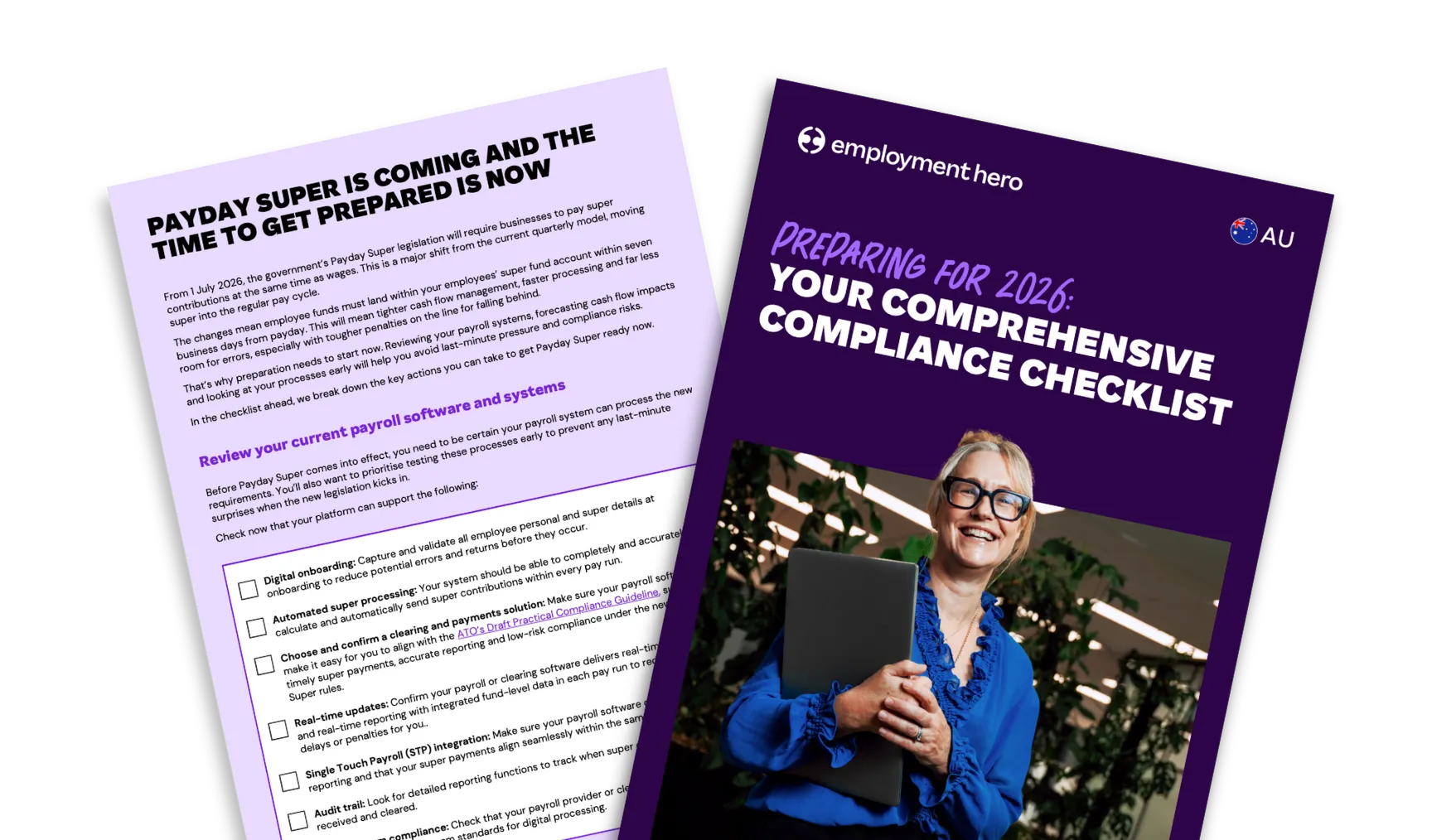Employee Value Proposition (EVP) Strategy Template
Published
Employee Value Proposition (EVP) Strategy Template
From recruitment through to retention, productivity through to employee engagement, having a clearly defined employee value proposition will help set up your organisation for long-term success.
What is an employee value proposition strategy?
Done well, a successful EVP strategy will provide answers to the question: Why work with us?
Having a strong employee value proposition can facilitate strong employer branding that is vital to talent acquisition and retention.
With that in mind, how will current and prospective employees know what makes working for your company so desirable if it’s not communicated to them?
You want to build a company that people will love, one that will invest in their team and stand the test of time. By prioritising your people’s happiness, it sends out a powerful message to employees and customers alike.
For a deeper understanding of what employees truly value, explore our Employee Value Proposition Survey Questions and Template. This resource provides valuable insights into crafting an EVP that resonates with your workforce.

Let’s have a quick EVP refresher
Employee Value Proposition (EVP) is the combination of support, benefits package and employee perks that a business offers employees in return for their knowledge and skills.
A strong EVP will help you attract talent whose values and goals align with those of your organisation.
By combining employer branding with engagement, EVPs can create a sense of meaning for current and future employees, making your business a highly desirable place to work.
According to Gartner, effective EVPs can decrease annual employee turnover by just under 70% and increase new hire commitment by nearly 30%.
For those of you who are new to the term EVP and are not entirely sure what they are, our wonderful CPO – Alex Hattingh, has covered what makes for a successful EVP and why they are important to your business.
How to use our EVP template
Whether you’re starting from scratch or refining what you already have, this EVP template can help you build a value prop that’s authentic, strategic, and aligned with what your people really care about.
Step 1: Understand what an EVP is and why it matters
Start by reading the quick explainer of the template. It outlines what an EVP includes (like benefits, recognition, and development), and why getting it right is important for attracting and keeping the best people. This section sets the stage for your strategy.

Step 2: Gather feedback from your team
Use the employee survey provided to understand what your team values most about their experience, and what they’d love to see improved. This survey covers key areas like:
- Mission and values
- Recognition and rewards
- Learning and development
- Workplace flexibility and benefits
Use Employment Hero’s engagement tools to digitise and distribute this anonymously for more candid responses.
Step 3: Review and analyse the results
Once your survey responses are collected, spend time analysing the trends and recurring themes. What do your people love? What’s missing? Use this information as your foundation.
Step 4: Host a leadership EVP workshop
Bring your key department heads together to review the survey results and brainstorm how to bring your EVP to life. Use the workshop prompts to guide your discussion on areas like:
- Recognition strategies
- Flexibility policies
- Upskilling opportunities
- Alignment with business goals
Encourage cross-functional input so your EVP reflects all corners of your organisation.

Step 5: Plan your initiatives
Move to the initiative planning table. For each EVP component you want to implement or improve, fill in:
- The initiative name (e.g. “Launch a learning stipend”)
- A to-do list to get it off the ground
- The estimated cost
- The person responsible
Start small and scale up, these initiatives can evolve over time.
Tips for creating a compelling employee value proposition
Everything you need to craft a standout EVP is right here in this template. As you work through it, keep in mind a few key principles.
It’s important to continuously rework, redefine and articulate your EVP to new and existing employees. Make it a habit to revisit, refine and communicate your EVP regularly, both to new hires and existing team members.
By continuously listening to feedback and tracking what resonates (and what doesn’t), you’ll stay aligned with what your employees truly value.
Before you dive into building out your EVP strategy, here are some helpful tips to guide your thinking.
Clearly define your employee personas
Employee personas can help you understand what your people value and the type of employee experience you should be creating for them.
This is the first step in truly understanding the various personalities, skills, experiences, knowledge, behaviours and attitudes that drive productivity and performance.
With today’s increasingly diverse workforce, every company has more than one type of employee. In fact, your business relies on different backgrounds and perspectives to understand customer profiles and facilitate innovation.
Just like you would a customer, starting by empathising with each employee’s target segment that is key to the EVP development process.
Listen to what your existing employees have to say
Once you have identified and examined the diverse needs within your company, start to engage with them to further your understanding.
You want to hear what employees seek in their workplace and what makes them feel happy, engaged and motivated to perform. These answers can be found in your past, current and prospective employees.
Leverage exit interviews to understand why it is that past employees have chosen to leave your company and what you could do differently in the future.
Use focus groups, 1:1 meetings and surveys for current employees to see what they enjoy about the existing employee experience and ideas for how it can be improved.
Interviews with prospective candidates can also provide a unique insight into what makes your company culture attractive and why that’s important.
What not to do when building your EVP
Even with the best of intentions, EVPs can fall flat when they’re vague, unauthentic or fail to reflect the real employee experience.
Common mistakes include copying competitors, creating a one-size-fits-all messaging, or neglecting feedback from current staff.
An EVP that overpromises but underdelivers can hurt more than help, and can lead to disillusionment or poor employer brand perception.
Examples of strong employee value proposition strategies
Employment Hero
If we do say so ourselves, our EVP at Employment Hero is a good example to follow. We’re here to make employment easier and more rewarding for everyone. We live this through a remote-first policy, personal L&D budgets, and clear career progression paths.
Our team is trusted to work autonomously and supported to grow, all while contributing to a mission that matters. It’s about creating a workplace where everyone can do their best work, wherever they are.
Scratch
Scratch, a direct-to-consumer dog food brand, puts people and pets first. Their EVP highlights flexibility, mission-driven work, and a supportive, transparent team culture.
Employees enjoy the freedom to work remotely, wellness days for people and pets, and the chance to make a difference in animal health and sustainability. Their culture reflects their product of being ethical, honest, and made with care.
Who Gives A Crap
The certified B Corp and toilet paper company brings fun, sustainability, and purpose to the forefront of its EVP. Employees are offered remote roles, paid time off to volunteer, and are part of a business that donates 50% of profits to sanitation projects.
Their EVP centres around making a real difference while working in a creative, transparent, and values-led environment.
Cost-effective employee value proposition strategies
For the majority of businesses, employee value propositions are characterised by a unique combination of five key elements: people, work, rewards, opportunities and environment.
Whether you prioritise learning and development or flexible work, be sure to ask yourself – what drives my employees to perform? Developing an affordable EVP strategy that attracts, nurtures and retains top talent has never been easier.
Through these four low-cost strategies, you’ll be on your way to providing a unique and rewarding employee experience in no time. If you have already established your EVP, we recommend following along to see if there are any areas in need of improvement.
1. Support Learning and Development (L&D) opportunities
Nowadays, you will find most jobseekers look beyond financial compensation to career growth opportunities and support from a company culture that encourages continuous training.
Offering educational resources and programs that enable employees to learn anytime, anywhere will set your business apart from competitors.
By focusing on concepts that are relevant to an employee’s individual needs and future career goals, you can make learning a valuable part of the work experience. L&D programs help empower employees to gain new skills and further their understanding.
People want to see how their job supports growth and contributes to their future career development.
This can be through:
- Skills-based training
- Leadership training
- Online courses
- Mentor programs
Online platforms such as Go1 (with its very own Employment Hero integration), Udemy and LinkedIn Learning can support your employees who wish to advance their skills and further their interests. Online courses are an excellent, cost-effective solution for businesses wishing to prioritise L&D in their EVP strategy.
If we take a look at an industry example, we can see that L&D is a key component of Google’s unique EVP:
“There’s no one kind of Googler, so we’re always looking for people who can bring new perspectives and life experiences to our teams. If you’re looking for a place that values your curiosity, passion, and desire to learn, if you’re seeking colleagues who are big thinkers eager to take on fresh challenges as a team, then you’re a future Googler.”
2. Provide greater work arrangement flexibility
Flexible work arrangements are of high value to many employees today. With modern technology allowing people to work across multiple locations and time zones, it’s no surprise companies are adopting the flexible working approach.
Flexible work is an umbrella term for any role which breaks the traditional 9-5, Monday-Friday, working standard. Whether it’s through offering a remote-based role, WFH opportunities or extended/additional lunch breaks, flexibility is an attractive EVP strategy for your business.
The best part is, it won’t come at the cost of productivity. In fact, flexible work is an excellent way to increase performance and retain talent! Embracing a flexible work culture speaks volumes to your employees about the importance of finding a healthy work-life balance.
At its core, flexibility provides employees with more control over where, when and how they operate. This helps to enhance employee engagement and foster an environment that supports meaningful work.
Marketing gurus – HubSpot have implemented flexible work strategies into their EVP to support employees and their personal lives:
“We’re dedicated to building an inclusive culture where employees can do their best work. Feedback, research, and our own employees show that the number one way to do that is by being flexible. Giving HubSpotters the freedom and flexibility to create their own work-life balance builds trust in our company, but it’s also just the right thing to do. That’s why flexibility is at the core of our benefits and culture, from family planning to financial planning.”
3. Implement a recognition program
Recognition programs, done right, can provide numerous benefits to both employees and businesses alike.
Luckily, you don’t need to spend crazy amounts on recognising hard work. A little recognition can go a long way in making your employees feel appreciated and valued for the work they produce.
Having a positive working environment with a strong recognition culture that motivates, supports and rewards employees extends far beyond material incentives.
Public acknowledgements and employee recognition using online platforms are excellent ways for employees to be recognised by both their colleagues and their superiors.
Some companies even offer L&D opportunities to recognise staff performance and support leadership development. Whether you choose to use a peer recognition platform like what we offer here at Employment Hero or say thank you in person, employee recognition can be a huge help in designing an unique employee value proposition.
4. Offer employee wellness programs
Over the last decade, we’ve seen a huge shift to a more strategic and people-focused HR. So it’s likely you’ve heard of employee wellness programs before.
Health and wellness initiatives aim to enhance the overall well-being of a company’s employees. Typically, employee wellness programs centre around mobility, physical activity, nutrition, wellbeing and mindfulness. By providing employees with the tools and resources to manage their health, wellness programs can improve productivity and engagement.
As health and wellness continue to be hot topics, it’s important for employers to take active measures to support employee wellbeing in their EVP. If you’re a little unsure where to begin, start by thinking of fun and exciting ways to reflect your company’s values and employee values.
For example, say your business is passionate about providing a safe, supportive and stress-free environment for your staff. A viable option would be to offer free mental health resources. Or if your teams thrive on competition, you could host a monthly step challenge with the whole company involved.
How to measure EVP success
Your EVP is a reflection of what your business truly offers its people, and it should be working hard for you behind the scenes. To understand if your EVP is successful, look at both perception and performance. You can start by asking:
- Are employees aware of and aligned with your EVP?
- Do candidates mention your EVP values in interviews?
- Is your EVP reflected in internal feedback, employee surveys, and retention data?
Once you’ve gathered those insights, you can begin measuring the effectiveness of your EVP. While your specific business goals will shape which metrics matter most, these core areas are a great place to start:
- Your Employee Net Promoter Score (eNPS): Are your people likely to recommend your workplace?
- Your engagement survey results: Is there alignment between what your EVP promises and how people feel at work in their day to day roles?
- Your retention and turnover metrics: Have retention rates improved since launching your EVP?
- Your offer acceptance rates: Are more candidates accepting roles with your business?
- Public reviews: Are external perceptions improving, how does your employer score look online? Maintaining employee satisfaction will encourage employees to leave positive reviews, which can attract culture-focused hires.
Once you start successfully improving your EVP, you should start to see the results of your work. This can include higher engagement and morale, improved retention and reduced recruitment costs, increased interest from qualified, values-aligned candidates, positive employee referrals and even a more cohesive or purpose-driven culture.
Build an irresistible employer brand
Just like employees, every organisation is different. That’s why your employer’s value proposition needs to be unique to your business and its individual values. For each of the EVP strategies mentioned above, start by considering how they can be tailored to fit employee targets and specificities.
The beauty is that there are several affordable EVP strategies that won’t break the bank. Meaning no matter the size of your business, you can still show your people that you care.
By implementing these four low-cost strategies, you’ll also rediscover why your company is an exciting place to work. Designing a supportive and well-thought-out EVP will help drive profitability, increase engagement, improve retention and attract top talent to your company.
Not to mention your current employees will also serve as strong brand ambassadors. It really is a win-win situation for everybody.
Need help crafting your EVP or want feedback on your existing one? Book a consult with our team
Building a compelling EVP doesn’t have to be overwhelming. If you’re not sure where to start, or you just want a second opinion, we’re here to help.
At Employment Hero, we’ve worked with thousands of businesses to help them attract and retain top talent through smart employee management. Whether you’re defining your EVP from scratch or refreshing an existing one, our team can support you with tools, templates and real-time insights.
Book a free call with our team, or explore our smart HR platform to see how we can help you make your business a magnet for top talent.
Register for the Worksheet Template
Related Resources
-
 Read more: HR Managers: Don’t just survive the festive season, master it
Read more: HR Managers: Don’t just survive the festive season, master itHR Managers: Don’t just survive the festive season, master it
Make year-end easier: manage leave, payroll, parties and shutdowns with confidence. Get practical tips for Australian SMEs. Download the free…
-
 Read more: Preparing for 2026: Your Compliance Checklist
Read more: Preparing for 2026: Your Compliance ChecklistPreparing for 2026: Your Compliance Checklist
Get your business ready for the 1 July 2026 changes. See practical steps for Payday Super, cash flow planning and…
-
 Read more: Monthly business budget template for employers
Read more: Monthly business budget template for employersMonthly business budget template for employers
Plan your monthly income and expenses with our free monthly business budget template. Download today to track cash flow and…























